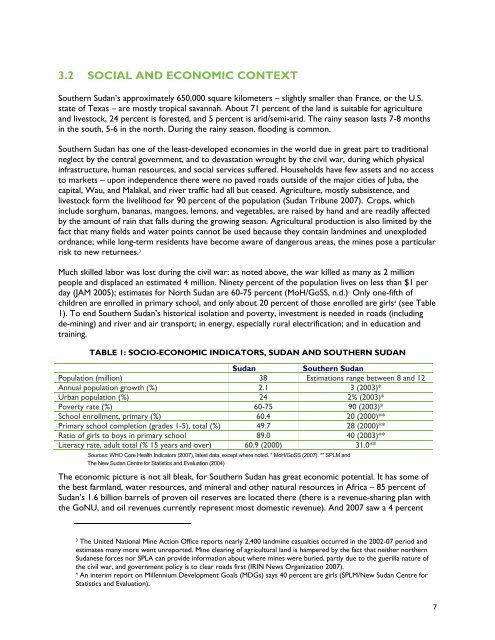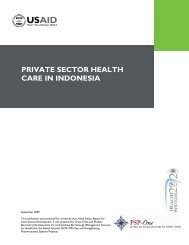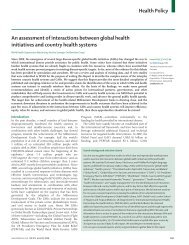southern sudan health system assessment - Health Systems 20/20
southern sudan health system assessment - Health Systems 20/20
southern sudan health system assessment - Health Systems 20/20
You also want an ePaper? Increase the reach of your titles
YUMPU automatically turns print PDFs into web optimized ePapers that Google loves.
3.2 SOCIAL AND ECONOMIC CONTEXT<br />
Southern Sudan’s approximately 650,000 square kilometers – slightly smaller than France, or the U.S.<br />
state of Texas – are mostly tropical savannah. About 71 percent of the land is suitable for agriculture<br />
and livestock, 24 percent is forested, and 5 percent is arid/semi-arid. The rainy season lasts 7-8 months<br />
in the south, 5-6 in the north. During the rainy season, flooding is common.<br />
Southern Sudan has one of the least-developed economies in the world due in great part to traditional<br />
neglect by the central government, and to devastation wrought by the civil war, during which physical<br />
infrastructure, human resources, and social services suffered. Households have few assets and no access<br />
to markets – upon independence there were no paved roads outside of the major cities of Juba, the<br />
capital, Wau, and Malakal, and river traffic had all but ceased. Agriculture, mostly subsistence, and<br />
livestock form the livelihood for 90 percent of the population (Sudan Tribune <strong>20</strong>07). Crops, which<br />
include sorghum, bananas, mangoes, lemons, and vegetables, are raised by hand and are readily affected<br />
by the amount of rain that falls during the growing season. Agricultural production is also limited by the<br />
fact that many fields and water points cannot be used because they contain landmines and unexploded<br />
ordnance; while long-term residents have become aware of dangerous areas, the mines pose a particular<br />
risk to new returnees. 3<br />
Much skilled labor was lost during the civil war: as noted above, the war killed as many as 2 million<br />
people and displaced an estimated 4 million. Ninety percent of the population lives on less than $1 per<br />
day (JAM <strong>20</strong>05); estimates for North Sudan are 60-75 percent (MoH/GoSS, n.d.) . Only one-fifth of<br />
children are enrolled in primary school, and only about <strong>20</strong> percent of those enrolled are girls 4 (see Table<br />
1). To end Southern Sudan’s historical isolation and poverty, investment is needed in roads (including<br />
de-mining) and river and air transport; in energy, especially rural electrification; and in education and<br />
training.<br />
TABLE 1: SOCIO-ECONOMIC INDICATORS, SUDAN AND SOUTHERN SUDAN<br />
Sudan<br />
Southern Sudan<br />
Population (million) 38 Estimations range between 8 and 12<br />
Annual population growth (%) 2.1 3 (<strong>20</strong>03)*<br />
Urban population (%) 24 2% (<strong>20</strong>03)*<br />
Poverty rate (%) 60-75 90 (<strong>20</strong>03)*<br />
School enrollment, primary (%) 60.4 <strong>20</strong> (<strong>20</strong>00)**<br />
Primary school completion (grades 1-5), total (%) 49.7 28 (<strong>20</strong>00)**<br />
Ratio of girls to boys in primary school 89.0 40 (<strong>20</strong>03)**<br />
Literacy rate, adult total (% 15 years and over) 60.9 (<strong>20</strong>00) 31.0**<br />
Sources: WHO Core <strong>Health</strong> Indicators (<strong>20</strong>07), latest data, except where noted. * MoH/GoSS (<strong>20</strong>07). ** SPLM and<br />
The New Sudan Centre for Statistics and Evaluation (<strong>20</strong>04)<br />
The economic picture is not all bleak, for Southern Sudan has great economic potential. It has some of<br />
the best farmland, water resources, and mineral and other natural resources in Africa – 85 percent of<br />
Sudan’s 1.6 billion barrels of proven oil reserves are located there (there is a revenue-sharing plan with<br />
the GoNU, and oil revenues currently represent most domestic revenue). And <strong>20</strong>07 saw a 4 percent<br />
3<br />
The United National Mine Action Office reports nearly 2,400 landmine casualties occurred in the <strong>20</strong>02-07 period and<br />
estimates many more went unreported. Mine clearing of agricultural land is hampered by the fact that neither northern<br />
Sudanese forces nor SPLA can provide information about where mines were buried, partly due to the guerilla nature of<br />
the civil war, and government policy is to clear roads first (IRIN News Organization <strong>20</strong>07).<br />
4<br />
An interim report on Millennium Development Goals (MDGs) says 40 percent are girls (SPLM/New Sudan Centre for<br />
Statistics and Evaluation).<br />
7
















